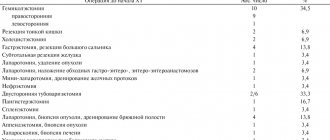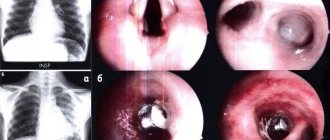Directions for use and doses
Orally, during meals, if necessary, regardless of meals.
Before use, the drug is mixed with liquid food, preferably a fermented milk product, for newborns and infants - with mother's milk or formula for artificial feeding. You can mix the drug with 30–50 ml of boiled water at room temperature, which will form a cloudy suspension with black sorbent particles. The resulting aqueous suspension should be drunk without achieving complete dissolution.
Children under 6 months - 1 pack. 2 times a day; from 6 months to 3 years - 1 pack. 3 times a day; from 3 years and older - 1 pack. 3–4 times a day; adults - 2 packs. 3 times a day.
The course of treatment for acute intestinal infections is 5-7 days, acute respiratory infections - 5-10 days, dysbiosis, diseases accompanied by disruption of the normal intestinal microflora, chronic gastrointestinal diseases and during the period of convalescence after illnesses - 10-15 days.
Florin forte, 30 pcs., powder for oral administration
BIOLOGICAL PROPERTIES
Florin® forte restores the normal microflora of the human body, suppresses the vital activity of pathogens of infectious diseases of the gastrointestinal tract and upper respiratory tract due to the live probiotic bacteria included in the drug: bifidobacterium bifidum, sorbed in the form of microcolonies, and lactobacilli (Lactobacillus plantarum).
The combined effect of bifidobacteria and lactobacilli sorbed on activated carbon in the form of microcolonies ensures accelerated normalization of the quantitative and qualitative composition, metabolic and functional activity of microflora, enhances the suppressive effect on pathogens of acute intestinal infections, acute respiratory viral infections and their removal from the body, increases the nonspecific resistance of the body .
Bifidobacteria that are part of the drug have an antimicrobial effect due to antagonistic activity towards pathogenic and conditionally pathogenic microorganisms, an immunomodulatory effect - they stimulate the synthesis of immunoglobulins, interferons, cytokines, participate in the formation of local immunity, activate the repair of mucous membranes and parietal digestion, produce short-chain enzymes fatty acids, lactic acid. Bifidobacteria are a biosorbent, neutralize toxins, accumulate toxic substances and remove them from the body.
Lactobacilli suppress the growth of pathogens due to the production of lactic acid, hydrogen peroxide, lysozyme, participate in the metabolism of proteins, fats, carbohydrates, nucleic and bile acids, activate the immune system, and prevent the formation of protracted forms of intestinal diseases by increasing the overall resistance of the body. Lactobacilli have a hypocholesterolemic effect, reduce the redox potential, and bind oxygen radicals harmful to bifidobacteria.
Lactobacilli and bifidobacteria have an enhanced suppressive effect on rotaviruses and hemolytic Escherichia coli, produce antibiotic-like substances - bacteriocins, participate in the synthesis of vitamins, and use lactose in the process of life as the main source of nutrition.
Not absorbed into the bloodstream.
Reviews
You can read patient reviews about the drug at the end of the article.
Most patients who have been prescribed Florin Forte respond positively to this drug. It works much more efficiently than its analogues.
It can be used not only to restore intestinal microflora and normalize its functioning, but also to treat acute infections and other gastrointestinal diseases. Young mothers thank the doctors who prescribed this probiotic to them. He helped them cope with intestinal problems caused by hormonal changes during the prenatal and postpartum period.
Video on the topic: Human digestive system.
Guinea
The coin owes its unusual name to Guinea, from which the precious metal came. This coin appeared in 1663, when Charles II reigned. The release of the guinea marked the transition from manual labor to industrial production, now also for gold coins. The guinea originally weighed 8.385 grams. With the arrival of the guinea, the unit disappeared from circulation. Now the guinea was the measure of twenty shillings. An interesting feature is the floating rate of this coin. The rise in gold prices ensured a gap from silver, and twenty-two shillings began to be given for the guinea. But this is not the limit, since the issue of 1813 (the last mintage of the guinea) is known, intended to support the military campaign of the Duke of Wellington, who was with his army in the Pyrenees. Such a guinea was already exchanged for twenty-seven shillings issued in banknotes.
Over time, the Guinea acquired its own coin series. The smallest denominations were the quarter guinea (issues of 1718 and 1762) and the third guinea (period 1797-1813). The half guinea made a significant mark in circulation, and large denominations were represented by two guineas and five guineas coins. In 1817, when the guinea turned out to be equal to twenty-one shillings, due to the inconvenience of calculations, it was replaced by the sovereign.
Shilling
Philologists may debate whether the name "shilling" comes from the English "shield" ("shield"), or its root in the Latin "solidus". Originally, a shilling was equal to only five pence. It became a dozen under William the First Conqueror. With all this, the shilling was not yet a coin, but simply a unit of account. The shilling was introduced into a coin in 1502 under Henry the Seventh. True, then it was called not so euphoniously - teston. This is a .925 silver coin, so weighing 9.33 grams it contained only 8.68 grams of precious metal. The exact reasons for the low popularity of this type of shilling are not known for certain, and its minting ceased for some period.
The shilling was revived by Henry the Eighth, who decided to radically save money by reducing the silver content to forty percent. The result was a copper coin coated with a silver layer. From walking, the silver was worn away. The protruding parts suffered the most. And the most prominent detail of the portrait of the monarch, made in full face and not in profile, was the nose. Therefore, wits called such coins not “teston”, but “old copper nose”.
The shilling was minted under his own name by Edward the Sixth, who returned the coin to its full silver content. On these shillings we will see the year indicated by Roman numerals. They also indicate the denomination (“XII” is the number of pence). Another representative of shillings with an original legend can be the coins of George the Second. In 1745, the British attacked a Spanish caravan in Peru. The winners received a significant cargo of silver as trophies. They decided to perpetuate the memory of the robbers who acted for the good of their homeland with the inscription “LIMA” on coins minted from the captured precious metal, because the battle took place on the road leading from Lima.
It is believed that regular minting has been carried out since 1816. In 1920, the silver in the shilling became exactly half. After the war, copper-nickel became the material used for harvesting. Since 1971, the shilling has been out of circulation. From a three-tier system (12 pence = shilling, 20 shillings = pound sterling) the system becomes a two-tier system, where only pounds and pence survived.
Instructions for use
Indications for use
The probiotic Florin Forte is used in the treatment of:
- Acute intestinal diseases of unknown etiology;
- Acute intestinal infections caused by opportunistic bacteria or rotaviruses;
- Chronic diseases of the gastrointestinal tract;
- Prolonged diarrhea;
- Dysbacteriosis;
- Food poisoning.
It is prescribed when a hemolytic bacillus is detected in the intestines, when the number of opportunistic bacteria increases, as well as when there is a deficiency of lacto- and bifidobacteria in the body.
Florin Forte is an effective drug for restoring intestinal microflora that is disturbed during the treatment of diseases of other organs with antibiotics and other potent drugs.
Sovereign (Pound sterling)
The first coin embodiment of the pound sterling, or rather, the two dozen shillings that made it up. The ancient sovereign appeared under Henry the Seventh in 1489. Here its related words will be the familiar ones “sovereign” and “sovereignty”. It turns out the name comes directly from “sovereign”, since the coin assumed the image of a monarch on the throne. The weight of that sovereign was 15.55 grams of gold of the 960th standard, which under Henry the Eighth decreased to 920th. During the reign of Elizabeth, the sovereign suddenly “grew” one and a half times, now it amounted to three dozen shillings, but a coin with a face value of twenty shillings began to be called a pound. James the First restored the previous equality, but lost the weight (by this time it was already 11 grams) along with the name (the coin is called “unit” because of the inscription “Faciam eos in gentem unam” - “I will make them one people”, and Since 1969, it has received the beautiful name “Laurel”).
The second coming of the sovereign happened in 1817. The basis was the restoration of the English monetary system after the victory over Napoleon. After all the transformations and adjustments, it turned out that the golden guinea corresponds to twenty-one shillings. A denomination equal to twenty shillings was required, and the coinage of sovereigns was resumed. The coin now weighs almost eight grams (7.98 of which 7.315 is precious metal). On the obverse there remains a portrait of the reigning monarch, while the reverse is given to St. George. Unlike Russian coins of our time, here the snake will die not from a spear, but from a sword. A half-sovereign coin also appears, made of gold of the same standard. Colonial coinage of sovereigns began in Sydney in 1655 and ended in Pretoria in 1932. There are two collectible sovereigns (1937 with a portrait of George the Fifth and 1953 with a portrait of Elizabeth the Second), which are classified as rare coins. The very first issue of 1817 also became a rarity, because only 3,574 copies were minted with this date). For international trade, the UK minted sovereigns from 1957 until 1982. Modern sovereigns made for collectors are also appearing. Below the article we have placed links where you can go to a description of sovereigns of different years of issue. As we can see, the paths of the golden twenty shillings and the real turnover have radically diverged. And the pound sterling itself in the form of an everyday coin was born in 1983.
Analogs
If for one reason or another the drug Florin Forte is not suitable for the patient, the doctor may prescribe another drug from the group of eubiotic MIBPs.
They are used in the treatment of allergic diseases, gastrointestinal diseases, hepatitis and cholecystitis, intestinal and stomach ulcers and a number of other diseases. Actively affects Shigella, enteropathogenic Escherichia coli, Proteus, staphylococci, etc. Among them:
- Bifidumbacterin (liquid concentrate of bifidobacteria);
- Probifor;
- Bifiform (available in capsules, sachets/powders, chewable tablets);
- Lifeak Probiotics;
- BifoVir powder;
- Liobifidum.
Side effects
A probiotic is a safe drug with no side effects. Its production is carried out without the use of genetically modified strains. The bacteria included in Florin Forte are isolated from the human body.
Therefore, the probiotic has increased activity. It is absolutely harmless. The only contraindication to its use is individual intolerance, manifested in the form of an allergic itchy rash on the skin. No cases of nausea or vomiting were recorded.
Precautionary measures
Florin Forte has no restrictions on use . It can be used to treat people of all ages.
These include newborns and infants, as well as women during pregnancy and breastfeeding.
Available without a prescription.
You should be careful when prescribing the drug to people with lactose intolerance.
It is prohibited to use the drug:
- With illegible markings;
- If the integrity of the powder bag is damaged;
- After the expiration date.
Storage conditions
The probiotic should be stored in a place securely protected from children. Maximum storage temperature is 10°C.
It is allowed to transport packages with the drug at a temperature of 20°C, but not more than 10 days. Shelf life, subject to storage and transportation conditions, is 12 months.
Florin
Of course, this florin should not be confused with the medieval gold coin that became widespread in England. The birth of the silver florin was facilitated by the upcoming transition to the decimal system. And this is not “Decimal Day” of 1971, which established the modern turn of the UK. The idea of getting rid of complex components has been in the air among English bankers for a long time, since the conversion from the English system to the decimal system, which was already widely used by neighboring states, greatly complicated the financial calculations of international trade. Therefore, the plans included the launch into circulation of previously unprecedented monetary units, which would amount to hundredths and tenths of a pound. The small unit never appeared, but the large one began to be minted in 1849, bearing the inscription “ONE FLORIN ONE TENTH OF A POUND.” However, there are very rare coins with the date “1848”.
The new coin could be called differently (“centum”, “dime” or “decade”). Immediately after its launch, the florin encountered circulation difficulties. For unknown reasons, they did not place on the obverse the piece “Dei Gratia” (the statement that the queen bears the proud title for a reason, but solely “by the grace of God”) in the general inscription that framed the portrait of the queen. Perhaps, symbolically, this particle was replaced by the fact that Victoria appeared in the crown. It seems to be nonsense, but not for pious England of that time. The coin was immediately nicknamed “Godless”.
Therefore, since 1852, the “lost” particle has been returned to its proper place, but the inscription itself is written in such an ornate font that the coin is now called the “Gothic Florin”. In addition, the date is formed by Roman numerals. Writing the year of issue in Arabic numerals resumed in 1887, when the coin changed its appearance in honor of Queen Victoria's Jubilee. The weight of the florin was 11.31 grams (of which 10.462 grams were pure silver). Changes in the diameter of the coin did not lead to changes in weight. The diameter once again undergoes a transformation in 1893. And Edward the Seventh changed not only the size of the coin, but also the design, placing Britannia on the reverse.
Note that in 1887 a two-florin denomination (“DOUBLE FLORIN”) appeared with double weight (22.6 grams). In 1890, their minting was stopped, as they began to be confused with the crown, which was slightly larger in diameter. The two florins managed to earn the nickname “The Barmaid’s Sorrow.” In dimly lit pubs, clever rascals tried to hand over a double florin (four shillings) instead of a crown (five shillings), which caused deep frustration when calculating revenue, which revealed noticeable daily shortfalls.
The twentieth century brought tremendous changes to the florin. Since 1920, it is already a billon, since only half of the silver in it becomes. Under George the Sixth, the beautiful word “florin” left the coin, giving way to the prosaic designation “two shillings”. Since 1947, copper-nickel has become the material for workpieces. Minting took place until 1967, and in 1971 the florin still fulfilled its historical purpose, returning as a ten pence coin. The old florin remained legal tender until 1 July 1993, when the tenpence piece changed its appearance and the old style coins (including the florin) were withdrawn from circulation.









